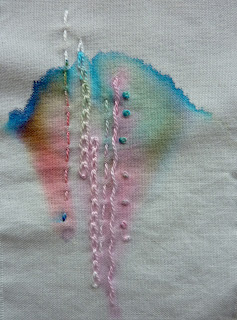This week we have been inducted into two new machines (the embellisher and the tufter) and a new foot (tailor tacking foot).
Although I like the pile created by the tufter, It doesn't seem that relevant to my work, so this week I have mainly been creating different samples with my knowledge of the Tailor tacking foot. However the few samples that I did do relating to the tufter were quite successful. They have a nice shape to them and were created by tufting along pleats in the fabric.
I feel that this piece is one of my most successful this week. The black top stitch of the tailor tacking foot blended with the background whilst creating texture, and the low tension on the white spool thread created these small bobbles. The shape reflects the shape of my chromatography experiments.
I have also experimented with layering stitches. This sample consists of layers of different taylor tacking stitches in different colours ontop of ice wool to give my fabric a textured quality.
I have also enjoyed trying out different ground fabrics, that I wouldn't already use such as this stiffer, gauze like fabric. This is actually the back of the normal taylor tacking stitch but I like the mix of tone between the bottom and top threads.
This fabric had a loose weave allowing me to pull our the warp and weft between stitches.
This Resida cotton bump fabric allowed the stitches to almost be swallowed by the fluff of the fabric, making the stitches look ghostly. The pattern was created by me marking the starting and ending points of ink at different points in my chromatography.
I have enjoyed experimenting this week, so for the last week of the project, I would like to create more machine samples with the techniques I have learnt, whilst linking them more to my data as this week, some have been solely technical.
I would like to experiment further with the idea of representing how the ink drags up the paper, and representing the movement of ink using lines rather than representing the shapes.
I would also like to try and link my hand and machine embroidery together so they arent two separate bodies of work.







































